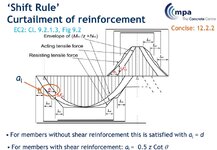IreStruEng
Structural
Say we have a short span simply supported RC beam with a point load so large at its midspan that the development length required is the full development length of the reinforcement.
Being a simply supported beam set up in this arrangement it's peak moment will be at midspan and the moment goes to zero at the supports. So at midspan we need a full development length and at the support technically the moment says no development length is needed as the rebar is not in tension anymore.
Is a fully developed bar required to extend into the supports in this scenario?
I'd typically fully develop all of my rebar unless space is an issue.
Being a simply supported beam set up in this arrangement it's peak moment will be at midspan and the moment goes to zero at the supports. So at midspan we need a full development length and at the support technically the moment says no development length is needed as the rebar is not in tension anymore.
Is a fully developed bar required to extend into the supports in this scenario?
I'd typically fully develop all of my rebar unless space is an issue.
Last edited:


